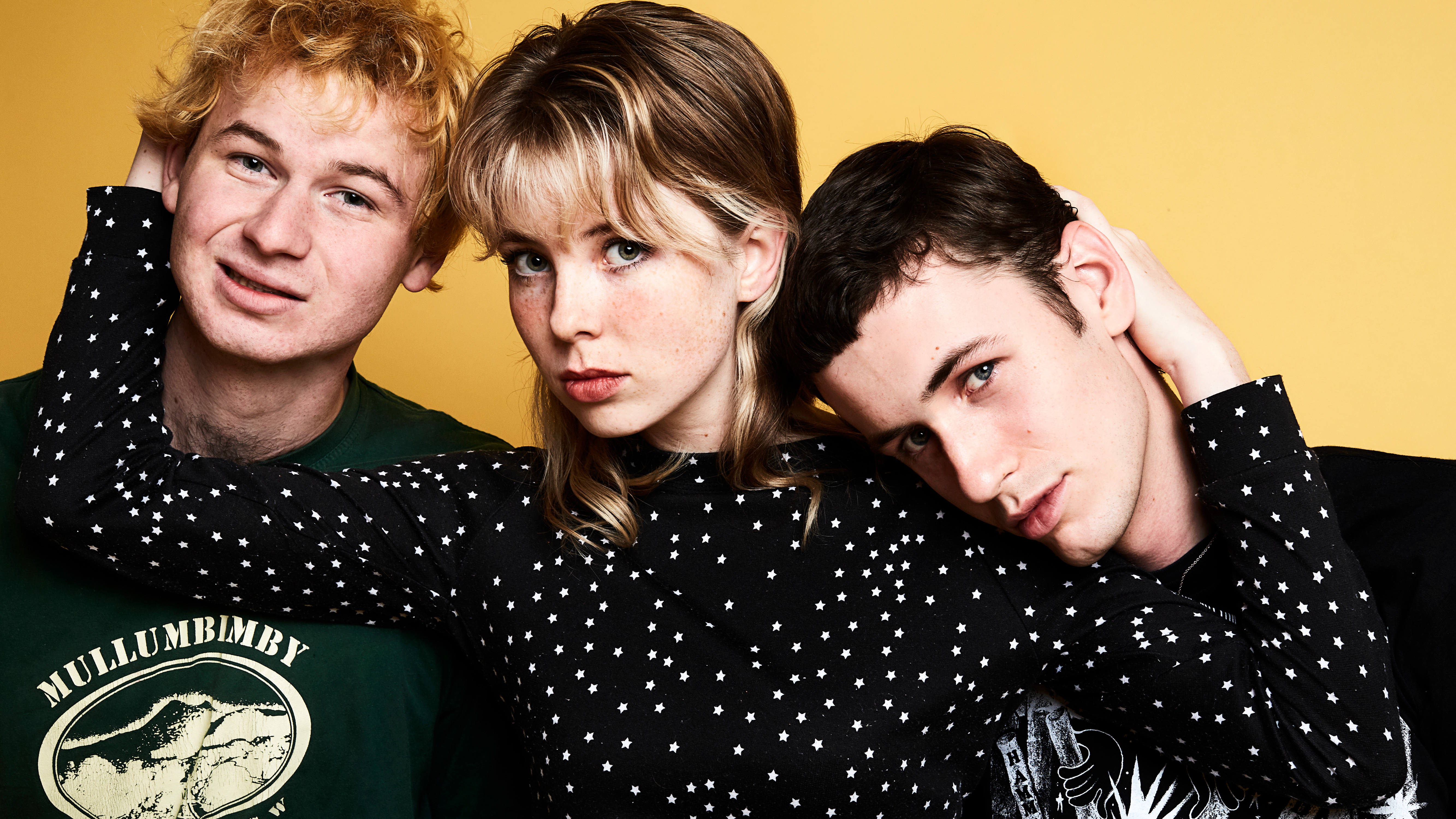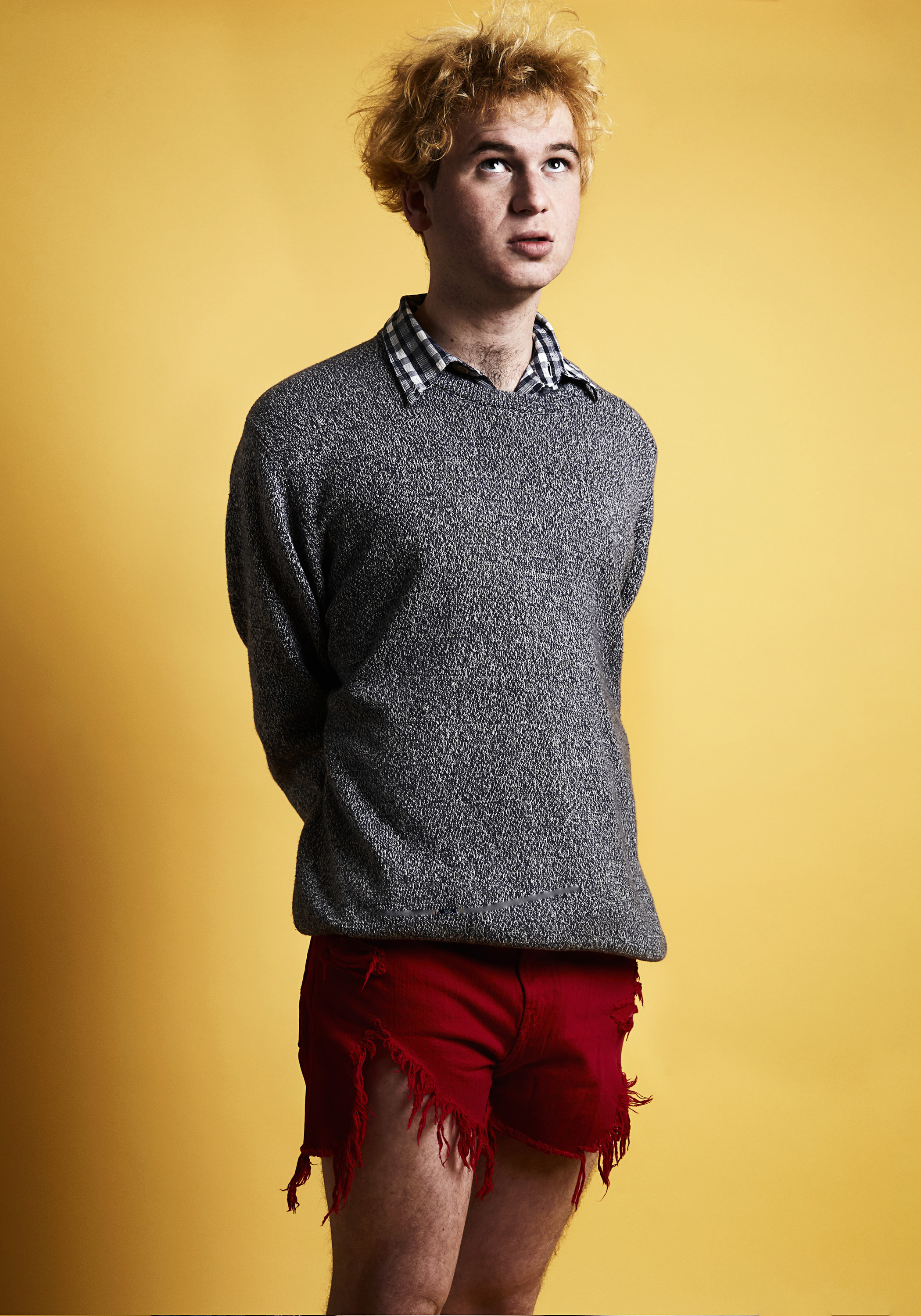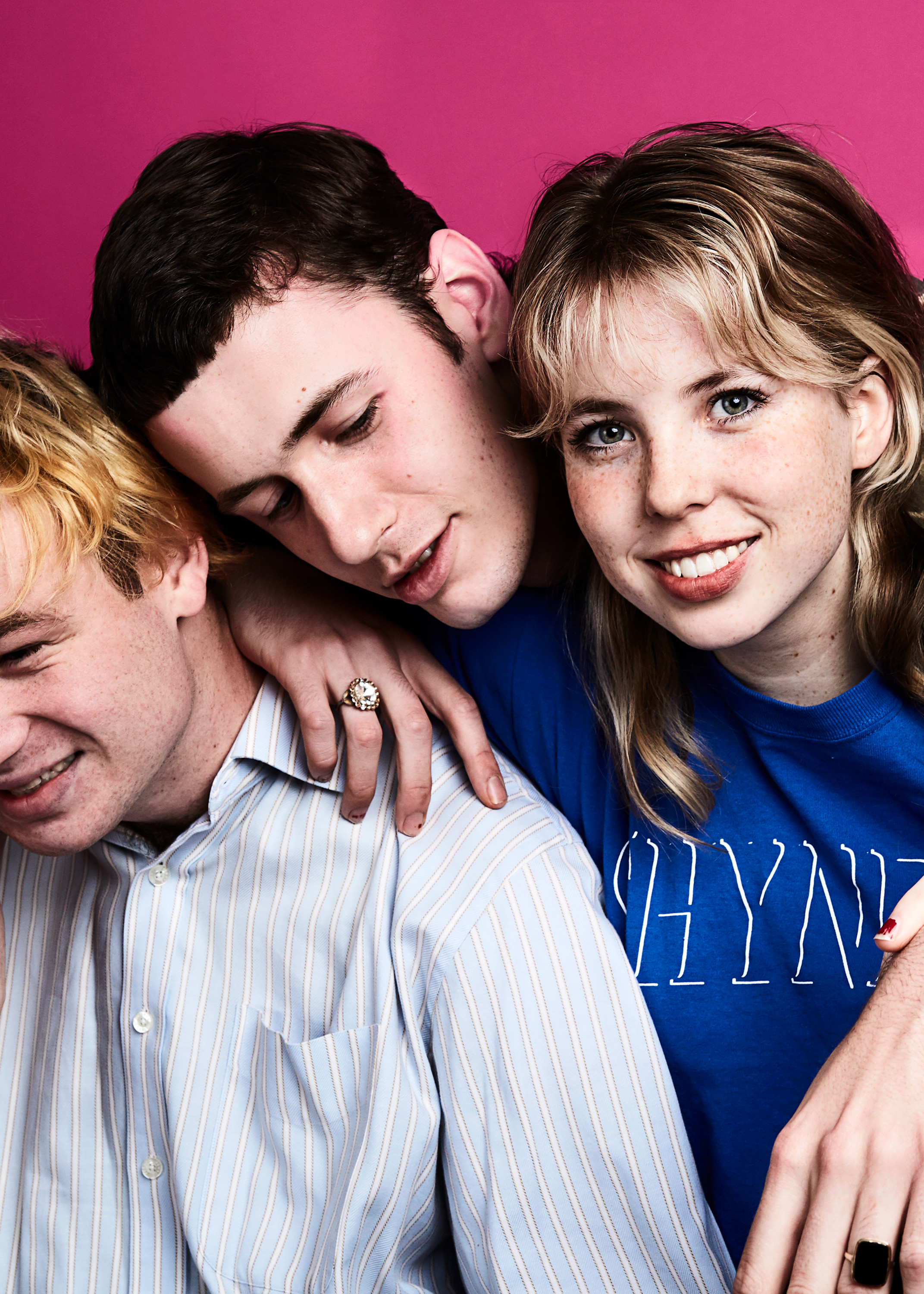There’s 30 minutes until The Goon Sax have to soundcheck for their show at Melbourne’s Gasometer Hotel, but I have a feeling they might have to postpone. We’re standing out the front of the house where the Brisbane three-piece’s gear is being stored, but nobody can seem to find the key. At a loss as to how we’ll get inside to retrieve the gear, each member of the band resorts to the break-in strategy they think will work best.
Riley Jones, the band’s drummer, takes to methodically combing the porch, checking underneath plants and on windowsills, before trying to use a bent coathanger to feel around underneath the door for a key. Louis Forster, who trades bass and guitar with bandmate James Harrison, picks up a rusty hacksaw and uses it to try and pry open the house’s locked windows. When that fails too, he walks around the side of the house to the back garden, where James is, somewhat inexplicably, trying to yell to anyone who might be inside.
Videos by VICE
After a good 20-30 minutes of different attempts, James clambers onto a pair of stacked milk crates, trying to reach through a half-shut window to unto its latch. It is, undoubtedly, the most convoluted way of getting into the house, and as we stand watching, Louis turns to me with a pained expression on his face. “I’m sorry,” he moans, “This kinda stuff just happens to us.” Eventually, James manages to unlatch the window, and he climbs through to let the rest of us in. The trio don’t really seem that phased.

Probably because this friendly kind of chaos seems to follow The Goon Sax wherever they go. I was meant to spent three hours––maybe four, max––with the Brisbane three-piece, but after a Rube Goldberg-ien series of events involving a messy lunch, a protracted photoshoot, and, of course, the lost house key, our three hours becomes seven. It’s no matter, though; despite the chaos, things are turning out just fine.
Since their debut in early-2016 with the precocious Up To Anything, The Goon Sax have found them lauded from all corners: NPR compared them to Talking Heads; The Guardian gave their record five stars. Pitchfork compared them to Courtney Barnett, as did Stereogum. And in support of Up To Anything, they toured with new-indie DIY luminaries like Frankie Cosmos, Whitney, and U.S. Girls. Despite the familiar narrative, there was something delightfully unformed about Up To Anything that saved The Goon Sax from the kind of quick flare-out that so often follows being labeled as An Indie Buzzband, and thankfully so. We’re Not Talking, the trio’s second album, out later this year on Chapter Music and Wichita Recordings, feels like the band’s proper introduction, a miraculous and hot-blooded indie rock record that reveals three ambitious, flawed, and wildly talented musicians underneath.
When I first meet The Goon Sax, they arrive in a tangle of limbs and bags and clothes. It’s an early start for them––11 AM––and they walk bleary-eyed into the room where they’ll be photographed for this feature, sleep-deprived after arriving in Melbourne late the night before.
All three Goon Sax are heartthrob-pretty and waywardly fashionable: James mild-mannered but striking with his shock of straw-yellow hair; Louis tall and angular, newly sporting a cool-boy fade; Riley with her beguiling almond-shaped grey eyes and a sleek blonde mullet, clad in an Angie t-shirt bearing the word ‘SHYNESS’. (It’s appropriate, and its sentiment would suit either of the others as well as it does Riley.) They look exceedingly cool together, despite the mess that’s slowly building around them as they try on different clothes for the shoot, and appear most comfortable when they’re around each other.

During the shoot, each member seems stunned when offered direction as to how to move their face or body, as if they’ve never looked in a mirror before. When they see each other’s portraits, it seems revelatory: “Louie, you look like a hunk!” whispers James to Louis; “These are beautiful,” tells Louis to Riley.
All three of them seem painfully shy, and so the dynamics of the group help deflect some of the attention. The way each member speaks feels perfectly balanced with the other two: Riley’s quiet voice offsets Louis’s broad almost-yell, and his terse, clear sentences in turn help give clarity to James’s mumblings, which tend to begin strong and fray into a trillion disparate strands. More often than not, these quips and anecdotes act as the trigger for a yelp or giggle from Riley. It feels like a perfect symbiosis, built over years of companionship.
The Goon Sax met as teenagers, and like many teenage friendships, it’s hard to really pin down how or why they became friends. After a hostile interaction with a waiter at the cafe we sit down to talk at later––probably, we decide, brought on as a result of James smoking too close to the door and Louis knocking over a vase within 25 seconds of us being there––the three try and work out the details for me.
“It was a bit romantic, being young, being in high school.” ––James Harrison
James, currently 21, and Louis, currently 20, first met about five or six years ago, through a mutual friend. They would go to James’s dusty, Queenslander-style home in Brisbane’s Kelvin Grove neighbourhood––an inner-city suburb a 45-minute bus ride away from Louis’s house––after school, where the two would hang out, doing nothing in particular.
The pair met Riley, currently 20, about a year later. James and Louis were in a band (the various names of which are “too bad to ever be printed”) whose members all had a crush on one girl, one of Riley’ friends, and the three became close, catching up after school and on weekends. It took a while for Riley to join James and Louis’s fledgling band, because despite wanting her to be part of the project, both boys were too shy to ask; according to James, they “didn’t think [they] were cool enough.”
On Friday afternoons, Riley and Louis, who both went to the selective-entry arts school Queensland Academies Creative Industries (QACI), would walk to Riley’s house––located, according to her, at the base of “like, the biggest hill in the world”––and Louis would nap on a couch on the veranda while Riley had drum lessons.

“It was a bit romantic,” says James, thinking back on the time. “The huge hills, a little house, being young, being in high school.” After Riley’s drum lessons, they would practise, slowly piecing together the songs that would end up forming their debut. The three didn’t know each other that well in the early stages of the band, but Riley says they warmed up quickly. “James has this thing where if he’s comfortable, suddenly you’re comfortable,” she recalls. In early practises, Louis says, James would make them get into one bed and “snuggle” and listen to Marvin Gaye, which helped the band’s relationship move along fast.
For the band, some feelings are constant: “Love,” according to Riley, “Feeling depressed,” according to Louis.
Despite the idyllic romance of band practise, school was hell for all three. James bristled at the early mornings and strict rules of his Catholic all-boys school, while Louis and Riley struggled under the weight of QACI’s intense academic regime. “[QACI] was really academic,” relays Louis, “I was always really stressed, and never sleeping.” The band’s shared anxieties of the time are partially chronicled on Up To Anything, which was written and recorded while the band were in high school. The band haven’t really heard much of the record since it came out, and only play a couple of the songs at shows. Mostly, that album just serves as a reminder for the band that some feelings––“Love,” according to Riley, “Feeling depressed,” according to Louis––are constant.
We’re Not Talking is largely concerned with those same themes, but it feels like a drastically different record. Where Up To Anything ambled, We’re Not Talking bolts, tripping over itself to get out ideas and words and feelings but still graceful all the same. From the second the record opens, with the brash, heartbroken “Make Time 4 Love”, it is animated by a ragged and wild thump, a pounding heartbeat that feels almost violent in its emotion. There’s a certain exuberant, yearning spirit about the record; it feels like a sharp intake of breath, the same feeling that comes before doing something new or terrifying––the sound of youth, of overflowing with a million contradictory emotions and thoughts at once. On early highlight “Love Lost”, for example, an attempt to go about a menial daily task (finding a book to read or movie to watch) can trigger a thousand other, weightier thoughts.

“It’s hard to decide what to read,” sings James decisively, before sliding into a different zone entirely: “It’s so hard to be who you want me to be.” Many of the tracks on We’re Not Talking are like this, simple songs about love that, by virtue of the time in which they were created, also articulate eternal truths about growing up and living in an often very bullshit world. On “Losing Myself”, Riley and James sing about the strange, bitter feeling of constant change that so often haunts when you’re young: “It feels like I’m losing myself, and that’s new to you” they sing, compounding a deeply internal kind of hurt into a taut, bright hook.
“People found that because we were young, the things that we were singing about were funny … We were singing about wanting to die, and it was weird when that became ‘cute teenage feelings’.” ––Louis Forster
“Certain people found that because we were young, the things that we were singing about were funny or cute,” says Louis. “We were singing about wanting to die, and it was weird when [that became] ‘cute teenage feelings’.” (Indeed, one review of Up To Anything describes the band as “confused, delicate and very, very teenage.”) Still, though, James acknowledges that there are advantages and perks to being young. “Youth is pretty appealing,” he says. “I like that I can smoke and drink as much as I want and not really care.”
We’re Not Talking looks beyond the boilerplate of ‘Australian Rock’, finding inspiration in avant legends like Jenny Hval, Pere Ubu, ESG and The Raincoats. Tracks like “Losing Myself” and “We Can’t Win” experiment with synths and drum machines, giving the music a hermetically sealed, internal feeling that’s true to the songs’ tone. Violins screech on “She Knows” as if laid down by Vicky Aspinall, while baroque horns on “Make Time 4 Love” cast Louis as a dour, sassy Jens Lekman, giving his theatrical vocal (one of the best on the record, going from romantic to downcast to straight-up petulant over the song’s runtime) an adequately dramatic padding.
Like Lekman, The Goon Sax have an innate talent for writing bald-faced love songs that don’t feel trite or sappy. “It felt important to talk about love because it was the first time I was in love, and that felt important,” says Louis matter-of-factly. “But I don’t think that’ll be something we’ll keep writing about in the same way.” For James, the way he sings about love on We’re Not Talking––specifically in that it’s unrequited love––is something he wants to leave behind, too. “I’m singing about unrequited love all the time,” he explains. “It’s lame. I don’t want to be writing as if I’m a victim.”
James doesn’t sound like a victim on We’re Not Talking. In fact, his songs are some of the most dazzlingly beautiful on the record, propelled by roguish charm and candor that doesn’t always come through in real life. James carries himself like he doesn’t quite want to be seen, hunched over and perpetually trailing off mid-sentence. (At one point, as we get into an Uber, I ask him if he’d like to sit front seat or back; in response, he tells me that I can sit with Riley and Louis if I want, as if he thinks I’m only occupied with those two, rather than the band as a whole.) His songs, on the other hand, are decisive and terse lyrically, strong-minded in contrast to his quiet demeanor. Vocal duties, which were split between Louis and James on the first record, are doled out fairly equally on We’re Not Talking, which serves the group well; the trio’s voices together add texture where Up To Anything sometimes felt one note. Sometimes, as on “Losing Myself”, where Riley sings portions of a song James wrote, the additional vocals create new narratives within the already rich lyrics.

“I find it hard to listen to the album,” admits Riley. “All we cared about at the time was being honest. And now it’s like ‘Oh yeah, we really achieved that’. It’s very honest.” So much so, in fact, that Riley hasn’t even heard the final version of “Somewhere In Between”, a spare interlude featuring only piano and vocals by Louis. “Would you rather see me as the person who loved and then left you?” he sings on the track, which is clouded with ambient noise. The lo-fi nature of “Somewhere In Between” wasn’t a specific stylistic choice. “I recorded it on Photo Booth on my laptop just so I could remember the chord sequence,” Louis recalls, “and then we ended up using that on the record. I’ve only heard it one or two times.”
“Sometimes, when we’re on tour and have to play these songs for people, I think I’m a bit of a sick fuck.” ––Louis Forster
None of the band knows quite where their urge for honesty comes from, but it guides their music all the same. When talking about the content of his lyrics, Louis seems disgusted with himself, as if he’s inflicting something on the people listening. “I wonder a lot about where the need to share comes from,” he says. “Sometimes I think it’s a beautiful thing and sometimes, when we’re on tour and have to play these songs for people, I think I’m a bit of a sick fuck. I’m such a sick fuck.” He laughs a little after spitting out the last part, but it doesn’t quite feel like he’s speaking in jest. When The Goon Sax discuss their own music, it’s like they’re self-analysing and critiquing in real time, trying to work out what impulses led to the album’s creation. Hearing the trio trying to discuss We’re Not Talking is not dissimilar to watching them try to find that misplaced house key; any and all attempts are made, with the hope that something will fit eventually.
And yet, for all the self-loathing they display, when The Goon Sax get onstage they exude nothing but passion and love for their work. After we finish talking, I watch the trio play to a packed out room at Melbourne’s Gasometer Hotel. The performance is a rush; when Riley, James and Louis perform together they conjure that same wild, yearning, urgent energy that We’re Not Talking does, but amplified. The set is loud and angular, in the style of many of their idols, and songs that haven’t even been released yet have already evolved a thousand times since their recording. That’s the thing about The Goon Sax––they’re hard to pin down. All their music, but especially We’re Not Talking, channels the pure, violent entropy of living; you can hardly expect any one song, even any one note, to stay the same. The group ends with an extra loud, extra fast version of “Make Time 4 Love”, and are received rapturously. The chaos is worth it.
The Goon Sax’s sophomore record We’re Not Talking is out September 14 via Chapter Music and Wichita Recordings.
Elliott Lauren is a photographer from Melbourne. Follow her on Instagram.
Shaad D’Souza is Noisey’s Australia & New Zealand editor. Follow him on Twitter.
More
From VICE
-

Screenshot: Nintendo -

Tromsdalstinden, Tromsø's 'magic mountain'. All photos by Frank L'Opez -

Image: Trade Coffee, Collage by VICE -

Screenshot: Midway
